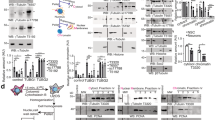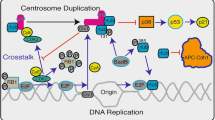Abstract
We have previously shown that the neuronal-associated class III β-tubulin isotype and the centrosome-associated γ-tubulin are aberrantly expressed in astrocytic gliomas (Cell Motil Cytoskeleton 2003, 55:77-96; J Neuropathol Exp Neurol 2006, 65:455–467). Here we determined the expression, distribution and interaction of βIII-tubulin and γ-tubulin in diffuse-type astrocytic gliomas (grades II-IV) (n = 17) and the human glioblastoma cell line T98G. By immunohistochemistry and immunofluorescence microscopy, βIII-tubulin and γ-tubulin were co-distributed in anaplastic astrocytomas and glioblastomas and to a lesser extent, in low-grade diffuse astrocytomas (P < 0.05). In T98G glioblastoma cells βIII-tubulin was associated with microtubules whereas γ-tubulin exhibited striking diffuse cytoplasmic staining in addition to its expectant centrosome-associated pericentriolar distribution. Treatment with different anti-microtubule drugs revealed that βIII-tubulin was not associated with insoluble γ-tubulin aggregates. On the other hand, immunoprecipitation experiments unveiled that both tubulins formed complexes in soluble cytoplasmic pools, where substantial amounts of these proteins were located. We suggest that aberrant expression and interactions of βIII-tubulin and γ-tubulin may be linked to malignant changes in glial cells.






Similar content being viewed by others
Abbreviations
- ANOVA:
-
Analysis of variance
- Cy3:
-
Indocarbocyanate
- DAPI:
-
4′-6-Diamidino-2-phenylindole
- DMEM:
-
Dulbecco’s modified Eagle medium
- EDTA:
-
Ethylene diamine tetraacetic acid
- EGTA:
-
Ethylene glycol tetraacetic acid
- FITC:
-
Fluorescein isothiocyanate
- GCP:
-
γ-Tubulin complex protein
- γ-TuRC:
-
Large γ-tubulin-ring complex
- γ-TuSC:
-
γ-Tubulin-small complex
- LI:
-
Labeling index
- MES:
-
2-(N-morpholine)-ethane sulphonic acid
- MLI:
-
Mean labeling index
- MSB:
-
Microtubule-stabilizing buffer
- MTOC:
-
Microtubule organizing center
- TBST:
-
Tris-Buffered Saline Tween-20
References
Katsetos CD, Herman MM, Mörk SJ (2003) Class III β-tubulin in human development and cancer. Cell Motil Cytoskeleton 55:77–96
Katsetos CD, Legido A, Perentes E et al (2003) Class III β-tubulin isotype: a key cytoskeletal protein at the crossroads of developmental neurobiology and tumor neuropathology. J Child Neurol 18:851–866
Dráberová E, Lukáš A Ivanyi D et al (1998) Expression of class III β-tubulin in normal and neoplastic human tissues. Histochem Cell Biol 109:231–239
Katsetos CD, Del Valle L, Legido A et al (2003) On the neuronal/neuroblastic nature of medulloblastomas: a tribute to Pio del Rio Hortega and Moises Polak. Acta Neuropathol (Berl) 105:1–13
Katsetos CD, Del Valle L, Geddes JF et al. (2001) Aberrant localization of the neuronal class III β-tubulin in astrocytomas: a marker for anaplastic potential. Arch Pathol Lab Med 125:613–624
Martinez-Diaz H, Kleinschmidt-DeMasters BK, Powell SZ et al (2003) Giant cell glioblastoma and pleomorphic xanthoastrocytoma show different immunohistochemical profiles for neuronal antigens and p53 but share reactivity for class III β-tubulin. Arch Pathol Lab Med 127:1187–1191
Katsetos CD, Del Valle L, Geddes JF et al (2002) Localization of the neuronal class III β-tubulin in oligodendrogliomas: Comparison with Ki-67 proliferative index and 1p/19q status. J Neuropathol Exp Neurol 61:307–320
Giannini C, Scheithauer BW, Lopes MB et al (2002) Immunophenotype of pleomorphic xanthoastrocytoma. Am J Surg Pathol 26:479–485
Aldaz H, Rice LM, Stearns T et al (2005) Insights into microtubule nucleation from the crystal structure of human γ-tubulin. Nature 435:523–527
Joshi HC, Palacios MJ, McNamara L et al (1992) γ-Tubulin is a centrosomal protein required for cell cycle-dependent nucleation. Nature 356:80–82
Zheng Y, Wong ML, Alberts B et al (1995) Nucleation of microtubule assembly by γ-tubulin-containing ring complex. Nature 378:578–583
Zhou J, Shu H-B, Joshi HC (2002) Regulation of tubulin synthesis and cell cycle progression in mammalian cells by γ-tubulin-mediated microtubule nucleation. J Cell Biochem 84:472–483
Inclan YF, Nogales E (2001) Structural models for the self-assembly and microtubule interactions of γ-, δ- and ε-tubulin. J Cell Sci 114:413–422
Llanos R, Chevrier V, Ronjat M et al (1999) Tubulin binding sites on γ-tubulin: identification and molecular characterization. Biochemistry 38:15712–15720
Paluh JL, Nogales E, Oakley BR et al (2000) A mutation in γ-tubulin alters microtubule dynamics and organization and is synthetically lethal with the kinesin like protein Pkl1p. Mol Biol Cell 11:1225–1239
Sulimenko V, Sulimenko T, Poznanovic S et al (2002) Association of brain γ- tubulins with αβ-tubulin dimers. Biochem J 365:889–895
Katsetos CD, Reddy G, Dráberová E et al (2006) Altered cellular distribution and subcellular sorting of γ-tubulin in astrocytic gliomas and human glioblastoma cell lines. J Neuropathol Exp Neurol 65:465–477
Stein GH (1979) T98G: an anchorage-independent human tumor cell line that exhibits stationary phase G1 arrest in vitro. J Cell Physiol 99:43–54
Ito H, Kanzawa T, Kondo S et al (2005) Microtubule inhibitor D-24851 induces p53- independent apoptotic cell death in malignant glioma cells through Bcl2 phosphorylation and Bax translocation. Int J Oncol 26:589–596
Alexander JE, Hunt DF, Shabanowitz J et al (1991) Characterization of posttranslational modifications in neuron specific class III β-tubulin by mass spectrometry. Proc Natl Acad Sci (USA) 88:4685–89
Lee MK, Tuttle JB, Rebhun LI et al (1990) The expression and posttranslational modification of a neuron-specific β-tubulin isotype during chick embryogenesis. Cell Motil Cytoskeleton 17:118–132
Lee MK, Rebhun LI, Frankfurter A (1990) Posttranslational modification of class III β-tubulin. Proc Natl Acad Sci USA 87:7195–7199
Katsetos CD, Frankfurter A, Christakos S et al (1993) Differential localization of class III β-tubulin isotype and calbindin-D28k defines distinct neuronal types in the developing human cerebellar cortex. J Neuropathol Exp Neurol 52:655–666
Katsetos CD, Karkavelas G, Herman MM et al (1998) Class III β-tubulin isotype (βIII) in the adrenal medulla: I. Localization in the developing human adrenal medulla. Anat Rec 250:335–343
Ziková M, Sulimenko V, Dráber P et al (2000) Accumulation of 210 kDa microtubule-interacting protein in differentiating P19 embryonal carcinoma cells. FEBS Lett 473:19–23
Kukharskyy V, Sulimenko V, Macůrek L et al (2004) Complexes of γ-tubulin with non-receptor protein tyrosin kinases Src and Fyn in differentiating P19 embryonal carcinoma cells. Exp Cell Res 298:218–228
Katsetos CD, Kontogeorgos G, Geddes JF et al (2000) Differential distribution of the neuron-associated class III β-tubulin in neuroendocrine lung tumors. Arch Pathol Lab Med 124:535–544
Nováková M, Dráberová E, Schürmann W et al (1996) γ-Tubulin redistribution in taxol-treated mitotic cells probed by monoclonal antibodies. Cell Motil Cytoskeleton 33:38–51
Libusová L, Sulimenko T, Sulimenko V et al. (2004) γ-Tubulin in Leishmania: cell- cycle dependent changes in subcellular localization and heterogeneity of its isoforms. Exp Cell Res 295:375–386
Sulimenko V, Dráberová E, Sulimenko T et al (2006) Regulation of microtubule formation in activated mast cells by complexes of γ-tubulin with Fyn and Syk kinases. J Immunol 176:7243–7253
Dráberová E, Sulimenko V, Kukharskyy V et al (1999) Monoclonal antibody NF-09 specific for neurofilament protein NF-M. Fol Biol. Praha 45:163–165
Dráberová E, Dráber P (1993) A microtubule-interacting protein involved in coalignment of vimentin intermediate filaments with microtubules. J Cell Sci 106:1263–1273
Dráber P, Lagunowich LA, Dráberová E et al (1988) Heterogeneity of tubulin epitopes in mouse fetal tissues. Histochemistry 89:485–492
Weickert CS, Webster MJ, Colvin SM et al (2000) Localization of epidermal growth factor receptors and putative neuroblasts in human subependymal zone. J Comp Neurol 423:359–372
Dumontet C, Isaac S, Souquet PJ et al (2005) Expression of class III β-tubulin in non-small cell lung cancer is correlated with resistance to taxane chemotherapy. Bull Cancer 92:E25–30
Kamath K, Wilson L, Cabral F et al (2005) βIII-tubulin induces paclitaxel resistance in association with reduced effects on microtubule dynamic instability. J Biol Chem 280:12902–12907
Kavallaris M, Kuo DYS, Burkhart CA et al (1997) Taxol-resistant epithelial ovarian tumors are associated with altered expression of specific β-tubulin isotypes. J Clin Invest 100:1282–1293
Mozzetti S, Ferlini C, Concolino P et al. (2005) Class III β-tubulin overexpression is a prominent mechanism of paclitaxel resistance in ovarian cancer patients. Clin Cancer Res 11:298–305
Ranganathan S, Benetatos CA, Colarusso PJ et al (1998) Altered β-tubulin isotype expression in paclitaxel-resistant human prostate carcinoma cells. Br J Cancer 77:562–566
Tommasi S, Mangia A, Lacalamita R et al (in press) Cytoskeleton and paclitaxel sensitivity in breast cancer: the role of β-tubulins. Int J Cancer
Moritz M, Braunfeld MB, Sedat JW et al (1995) Microtubule nucleation by γ-tubulin- containing rings in the centrosome. Nature 378:638–640
Moritz M, Zheng Y, Alberts BM et al (1998) Recruitment of the γ-tubulin ring complex to Drosophila salt-stripped centrosome scaffolds. J Cell Biol 142:775–786
Oegema K, Wiese C, Martin OC et al. (1999) Characterization of two related Drosophila γ-tubulin complexes that differ in their ability to nucleate microtubules. J Cell Biol 144:721–733
Linhartová I, Novotná B, Sulimenko V et al (2002) γ-Tubulin in chicken erythrocytes: changes in localization during cell differentiation and characterization of cytoplasmic complexes. Dev Dynam 223:229–240
Detraves C, Mazarguil H, Lajoie-Mazenc I et al (1997) Protein complexes containing γ-tubulin are present in mammalian brain microtubule protein preparations. Cell Motil Cytoskeleton 36:179–189
Dryková D, Cenklová V, Sulimenko V et al (2003) Plant γ-tubulin interacts with αβ-tubulin dimers and forms membrane-associated complexes. Plant Cell 15:465–480
Rickman DS, Bobek MP, Misek DE et al (2001) Distinctive molecular profiles of high-grade and low-grade gliomas based on oligonucleotide microarray analysis. Cancer Res 61:6885–6891
Lopes MB, Frankfurter A, Zientek GM et al (1992) The presence of neuron-associated microtubule proteins in the human U-251 MG cell line. A comparative immunoblot and immunohistochemical study. Mol Chem Neuropathol 17:273–287
Ignatova TN, Kukekov VG, Laywell ED et al (2002) Human cortical glial tumors contain neural stem-like cells expressing astroglial and neuronal markers in vitro. Glia 39:193–206
Tarapore P, Fukasawa K (2002) Loss of p53 and centrosome hyperamplification. Oncogene 21:6234–6240
Ohgaki H, Kleihues P (2005) Population-based studies on incidence, survival rates, and genetic alterations in astrocytic and oligodendroglial gliomas. J Neuropathol Exp Neurol 64:479–489
Acknowledgments
We thank Dr. Jennian F. Geddes, Department of Histopathology and Morbid Anatomy, Queen Mary, University of London, The Royal London Hospital, London, England and Dr. Theodoros Maraziotis, Department of Neurosurgery, University Hospital, Patras, Greece for the procurement of archival tissue material from brain tumor cases. We thank Dr. Anthony Frankfurter, Department of Biology, University of Virginia, Charlottesville, for his gift of monoclonal antibody TuJ1 and the polyclonal antibody to βIII-tubulin. Supported by an Established Investigator Award from the St. Christopher’s Foundation for Children (to C.D. Katsetos), LC545 from the Ministry of Education of the Czech Republic, and by Institutional Research Support AVOZ 50520514 (to P. Dráber).
Author information
Authors and Affiliations
Corresponding author
Additional information
C.D. Katsetos and E. Dráberová contributed equally to this work.
Rights and permissions
About this article
Cite this article
Katsetos, C.D., Dráberová, E., Šmejkalová, B. et al. Class III β-Tubulin and γ-Tubulin are Co-expressed and Form Complexes in Human Glioblastoma Cells . Neurochem Res 32, 1387–1398 (2007). https://doi.org/10.1007/s11064-007-9321-1
Received:
Accepted:
Published:
Issue Date:
DOI: https://doi.org/10.1007/s11064-007-9321-1




